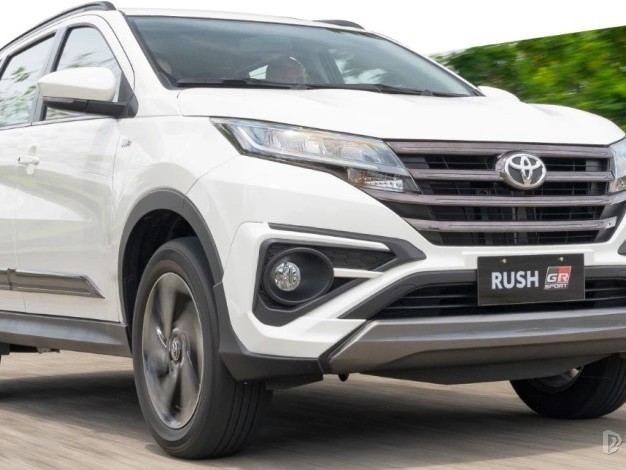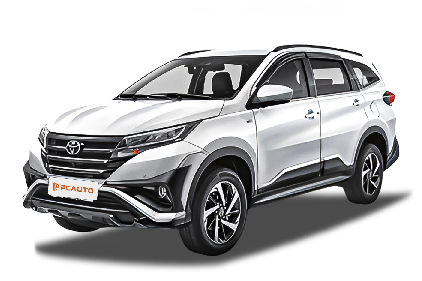Q
Is Toyota Rush small?
The Toyota Rush belongs to the small SUV category. Its body length, width, and height are 4,435 mm, 1,695 mm, and 1,705 mm respectively, with a wheelbase of 2,685 mm. Such dimensions make it relatively compact among SUV models. Although the overall body size is not large, it features a 2+3+2 seating layout as a 7-seater vehicle, accommodating the travel needs of multiple passengers. However, due to limited cabin space, using the third-row seats significantly reduces trunk capacity to just 213 liters. Nevertheless, its design prioritizes narrow roads and mountainous terrain. The compact body enhances maneuverability in tight spaces and simplifies parking, making it ideal for daily urban commutes and challenging road conditions while fulfilling diverse transportation requirements.
Special Disclaimer: This content is published by users and does not represent the views or position of PCauto.
Related Q&A
Q
Is Toyota Rush a Jeep?
The Toyota Rush is not a Jeep in the traditional sense, but rather a compact SUV built on the Toyota IMV platform, which leans more towards urban travel in the Malaysian market. This model features a higher ground clearance of approximately 220mm along with a robust and boxy exterior design, offering some light off-road capability. However, its primary focus remains on daily commuting and family use as a city-oriented SUV.
The Rush is equipped with front-wheel drive (with an optional four-wheel drive available in certain markets) and is powered by a 1.5L naturally aspirated engine (2NR-VE model) that delivers a maximum output of 104 PS. The vehicle's tuning prioritizes fuel efficiency over hard-core off-road performance. Compared to professional off-road vehicles like the Jeep Wrangler or Toyota's Land Cruiser series, the Rush lacks features such as part-time four-wheel drive and differential locks, but its compact size and nimble handling make it practical for various road conditions in Malaysia.
For users who occasionally need to tackle muddy or rocky terrain, opting for the four-wheel drive version and adding a skid plate is advisable. However, for serious off-roading, more specialized models are recommended.
Q
How many people can sit in a Toyota Rush?
The Toyota Rush can accommodate up to seven passengers. It features a 3+2+2 seating layout, which is a common configuration for seven-seater vehicles. This arrangement offers flexibility in passenger seating options. The middle row seats come with a 60:40 split-folding design, allowing for one-touch folding and manual adjustment of the incline angle, while the rear row utilizes a 50:50 split-folding design.
This versatility enables various seating configurations to cater to different needs, such as providing extra space for passengers or increasing cargo capacity. Whether you're traveling with family or friends, the seven-seat layout of the Toyota Rush offers a convenient option for group outings.
Q
Is a Toyota Rush AWD?
No, the Toyota Rush available in Malaysia is not an all-wheel drive (AWD) vehicle; it is equipped with a rear-wheel drive (RWD) system. This rear-wheel drive setup provides good balance and handling across various driving conditions. With its seven-seat layout, practical interior space, and decent off-road capability despite being RWD, the Toyota Rush has become a popular choice in the local SUV segment.
It comes with a range of safety features, including multiple airbags and electronic stability control, while the comfortable cabin layout enhances the overall driving experience. Its fuel-efficient gasoline engine and other convenient amenities cater to the needs of many local consumers.
Q
Is the Toyota Rush a CVT or automatic?
The Toyota Rush is equipped with an automatic transmission (AT), rather than a continuously variable transmission (CVT). The AT, which utilizes a hydraulic torque converter, connects to the engine and employs internal planetary gears to facilitate gear shifting and torque conversion. Both the 2019 Toyota Rush 1.5G AT and 1.5S AT feature this automatic transmission.
On the other hand, a CVT uses two variable-diameter pulleys and a steel belt to continuously and seamlessly adjust the gear ratio. The AT in the Toyota Rush offers automatic characteristics, allowing drivers to enjoy convenience without the need for manual shifting. This enhances the driving experience by making it more relaxed. Furthermore, the Rush's AT helps deliver the engine's power smoothly to the wheels, ensuring a comfortable ride. With its smooth shifting and reliable operation, the automatic transmission in the Toyota Rush meets the daily driving needs of many consumers.
Q
Is Toyota Rush expensive?
The price of the Toyota Rush ranges from RM 93,000 to RM 97,000, and whether this is considered expensive largely depends on individual perspectives and needs. For consumers on a tight budget who require a seven-seater vehicle, this price range may be quite reasonable, especially given the array of standard safety and practical features it offers, including six airbags, electronic stability control, and a 360-degree parking camera system.
From a segment perspective, this pricing is in line with the market positioning for a B-segment compact SUV. However, consumers seeking higher performance or luxury features may find it pricey, especially considering the engine produces a maximum output of 105 PS and that the majority of the seat adjustments are manual.
Q
What type of car is the Toyota Rush?
The Toyota Rush is classified as a B-segment vehicle. With a length of 4,435 mm, width of 1,695 mm, height of 1,705 mm and wheelbase of 2685mm, it features a five-door, seven-seat layout that is suitable for family use. The vehicle weighs between 1,300 and 1,305 kg, and has a fuel tank capacity of 45 liters.
Powering the Rush is a 1.5-liter gasoline engine that delivers a maximum output of 105 horsepower, paired with a rear-wheel-drive system and an automatic transmission (AT). The front suspension consists of MacPherson struts, and the braking system is equipped with ventilated disc brakes.
Safety features are extensive and include an anti-lock braking system (ABS), electronic stability control, and six airbags. Comfort features are well-appointed, with standard automatic climate control, a touchscreen infotainment system, and electric accessories. The seating configuration provides flexibility for both passengers and cargo.
Q
How fast can a Toyota Rush drive?
The Toyota Rush is powered by a naturally aspirated 1.5-liter four-cylinder gasoline engine, which produces 105 horsepower at 6,000 RPM and generates 140 Nm of torque at 4,200 RPM. It is paired with an automatic transmission and features a rear-wheel-drive layout.
While there is currently no official information regarding the Toyota Rush's top speed, considering its engine power, torque, and vehicle characteristics, it may achieve a maximum speed of approximately 160 to 180 km/h under ideal conditions. However, this is merely an estimate.
It is important to note that speeding is not only dangerous but also violates traffic regulations. The focus should be on maintaining a safe driving speed. Additionally, factors such as road conditions, vehicle load, and engine status can impact the actual attainable speed.
Q
What is the safety rating of Toyota Rush?
The Toyota Rush excels in safety features, offering a range of equipment designed to protect both drivers and passengers. Standard active safety systems include ABS (Anti-lock Braking System), Electronic Stability Control, Lane Departure Alert, Automatic Emergency Braking, and Forward Collision Warning, all of which work together to effectively prevent accidents.
In terms of passive safety, the vehicle is equipped with six airbags, including those for the driver, front passenger, front side airbags, and curtain airbags for both front and rear passengers, providing comprehensive protection for occupants. Additionally, the ISOFIX child seat anchors offer safety and convenience for families traveling with children.
While there is no specific safety rating data available, the rich and practical safety features of the Toyota Rush suggest a high level of protection for those inside the vehicle, offering driving safety on every journey.
Q
Can a Toyota Rush go uphill?
The Toyota Rush is capable of tackling inclines with ease. It is equipped with a 1.5-liter gasoline engine that delivers a maximum power output of 105 horsepower. Under normal conditions, this level of power is sufficient to propel the vehicle uphill. Additionally, features like rear-wheel drive provide enhanced traction and stability when ascending.
The vehicle also comes standard with a Hill Start Assist feature, which prevents rollback when starting on a slope, giving drivers added confidence during incline driving. With a ground clearance of 220 millimeters, the Rush is well-equipped to handle rugged terrain without the risk of wearing the bottom. With these capabilities, the Toyota Rush is well-prepared to navigate climbing scenarios effortlessly.
Q
Is a Toyota Rush a 7-seater layout?
Yes, the Toyota Rush is a 7-seater vehicle. It features a 3+2+2 seating configuration, comfortably accommodating seven passengers. This makes it a practical choice for families or groups in need of extra seating. Compared to smaller vehicles, its seven seats provide the flexibility to transport more people.
Whether for daily commutes, road trips, or carrying larger groups, the 7-seat configuration of the Toyota Rush offers convenience and practical functionalities. Additionally, the interior design and seating arrangement are crafted to ensure sound comfort for all passengers.
Latest Q&A
Q
How much is the 2024 Crown XLE?
The official price of the 2024 Toyota Crown XLE currently ranges from approximately RM250,000 to RM300,000, with the exact figure potentially varying based on optional configurations, dealer discounts, or promotional activities. This model is equipped with a 2.5-liter hybrid system that delivers a combined 234 horsepower, paired with an electronic all-wheel-drive system. It achieves a fuel consumption of around 5.6L/100km, balancing performance and fuel efficiency nicely. Standard features include a 12.3-inch infotainment screen, Toyota Safety Sense 3.0, a panoramic sunroof, and leather seats, among other premium touches. Notably, as Toyota's flagship sedan, the 2024 Crown rides on the new TNGA-K platform, which enhances body rigidity while lowering the center of gravity, resulting in noticeably improved handling stability compared to its predecessor. When considering competitors in the same class, you might compare it to hybrid versions of the Honda Accord or Nissan Teana, but the Crown XLE holds an edge in terms of sound insulation and rear passenger space. It's advisable to visit an authorized dealership for a test drive before purchasing to experience the suspension tuning and the hybrid system's smoothness firsthand, and keep an eye out for possible special offers during year-end auto shows.
Q
Is the Toyota Crown 2024 electric or gas?
The 2024 Toyota Crown currently offers a variety of powertrain options, including traditional gasoline versions and hybrid versions, but there's no pure electric variant available yet. The gasoline models come with either a 2.5-liter four-cylinder engine or a 3.5-liter V6, while the hybrid pairs a 2.5-liter engine with an electric motor, balancing fuel efficiency and performance. Design-wise, this car blends elements of a sporty coupe and a luxury sedan, packing advanced driver assistance systems and tech features like a full digital instrument cluster and a large infotainment screen. Even though there's no pure EV option right now, Toyota is ramping up its electrification efforts globally, so we might see more new energy models down the line. For eco-conscious buyers, the hybrid is a solid pick—it delivers better overall fuel economy than traditional gas-powered cars, and you don't have to stress about charging infrastructure. The Crown lineup has always been known for comfort and reliability, and the 2024 model carries on that tradition while stepping up interior quality and sound insulation. If you're set on a pure electric vehicle, keep an eye on Toyota's bZ series or check out EVs from other brands—there are already plenty of choices in the local market.
Q
Where is the 2024 Toyota Crown made?
The 2024 Toyota Crown is primarily built at Toyota's Motomachi Plant in Japan, a facility renowned for crafting premium models and prioritizing craftsmanship. This car rides on Toyota's latest TNGA-K platform, striking a balance between handling stability and ride comfort. Under the hood, you've got two choices: a 2.5-liter hybrid and a 2.4-liter turbocharged hybrid. The latter comes with the DIRECT4 electronic all-wheel-drive system, which smartly distributes torque to enhance cornering performance. It's worth noting that as Toyota's flagship model, the Crown's hybrid system has been specially tuned to deliver more immediate power response while keeping fuel consumption low. Local buyers might notice it leans more into sporty styling than traditional Toyotas, with things like the sloping roofline and 21-inch wheels, yet the interior remains spacious, with rear legroom that's top-notch for its class. On the after-sales front, Toyota offers an 8-year/200,000-kilometer warranty for the hybrid battery and a 5-year/100,000-kilometer warranty for the powertrain, so you can drive with peace of mind. Even though it's positioned as a premium offering, maintenance costs aren't drastically different from regular Toyotas, with routine service recommended every 10,000 kilometers or 6 months.
Q
How much does a 2024 Toyota Crown Platinum cost?
The 2024 Toyota Crown Platinum, as the flagship model, is expected to be priced between RM 350,000 and RM 400,000, depending on optional configurations and dealer promotions. It's powered by a 2.4-liter turbocharged hybrid system with a combined output of 340 horsepower, paired with an electronic all-wheel-drive system, delivering impressive performance and fuel efficiency. Inside, you'll find premium leather seats, a 12.3-inch digital instrument cluster, and a head-up display, packing plenty of tech appeal. On the safety front, it comes standard with Toyota Safety Sense 3.0, which includes pre-collision warning and full-speed adaptive cruise control. Positioned between luxury and sportiness, the Crown Platinum prioritizes comfort more than its German rivals in the same price bracket, while offering better value for money compared to Lexus models. Recent fluctuations in the Japanese yen exchange rate might affect the final selling price, so it's advisable to compare packages from different dealers before making a purchase—some dealerships may even offer perks like free maintenance or low-interest financing.
Q
What is the difference between 2024 and 2025 Toyota Crown?
The main differences between the 2024 and 2025 Toyota Crown lie in exterior details, equipment upgrades, and powertrain refinements. The 2025 model likely gets sharper lines and updated LED lighting up front, while interior materials and tech get a boost too—think a bigger infotainment screen or the latest multimedia system. Under the hood, the 2025 Crown probably sees improved hybrid efficiency for better fuel economy, and some markets might even get new powertrain options. For fans of the model, the 2025 updates are more about tweaking details and enhancing the user experience rather than a full redesign. So if you're watching your budget, the 2024 version still holds up as a solid pick. With its long history, the Toyota Crown has always been known for comfort and reliability, and the new model keeps that tradition alive—perfect for buyers who value quality and practicality.
View MoreRelated News

The compact SUV Toyota Rush, which has already been discontinued in Malaysia, does anyone around you drive it?
AshleyJul 25, 2024

Toyota Leads Global Sales in 2023, Despite 8% Decline but Tops Thailand
Kevin WongFeb 23, 2024

Toyota unveils the new Corolla at the Auto Guangzhou in China. What changes will the future Corolla have?
AshleyNov 25, 2025

Why is the facelifted GR Yaris considered the finished product?
AshleyNov 21, 2025

Toyota is developing two new Land Cruiser models, will Land Cruiser become an independent brand in the future?
JamesNov 20, 2025
View More















Pros
Cons